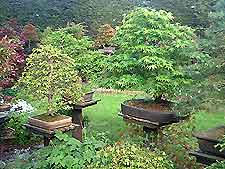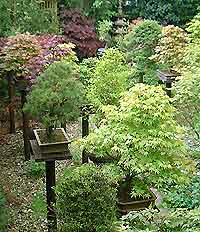Bonsai Trees
Feeding

Growing in such a small amount of soil, it is easy for a bonsai tree to become deficient when not fertilised adequately. Despite popular belief, bonsai are certainly not starved to keep them dwarfed! When to feed, what kind of fertiliser and how much all depend on the growth that is required.
A young tree may need heavy feeding so that it grows vigorously and therefore a fertiliser with a high nitrogen content should be selected. However, a mature, well developed deciduous bonsai should be fed sparingly so that the fine tracery of twigs does not become thick and clumsy. You can control exactly how your tree grows by correct feeding.
Only trees that have healthy, established root systems should be fed. For freshly repotted trees, commence fertilising using weak liquid feeds, at least one month after root pruning has been undertaken. When repotting trees, it is a good idea to add a small amount of slow release fertiliser granules to the soil mix. These will activate and provide a basic feed as the soil temperature rises, although supplementing with other feeds may be required later.
Fertilisers contain three main elements - N.P.K. - nitrogen (for foliage), phosphorus (for roots) and potassium (for flowers). Therefore a fertiliser with an N.P.K. ratio of 10:5:5 has a high nitrogen content and will promote strong growth. To encourage flowering use feeds high in potash, such as bone meal, which can be sprinkled on the soil in the autumn. To harden off new growth for the winter, reduce the nitrogen content towards the end of the summer, switching to a feed such as tomato fertiliser and then to a specialist bonsai fertiliser with N.P.K. ratio of 0:10:10, containing no nitrogen.

Liquid feeding has the advantage that it can quickly improve the appearance of a yellowing, deficient tree. Never exceed the dose stated on the packet, but instead always mix slightly weaker than the recommended dosage - 1/2 to 3/4 strength is ideal and will make sure that the roots are never scorched. Feeding weaker solutions little and often is far better than occasional strong feeds. Before feeding, water the trees thoroughly so that all of the fertiliser can be fully absorbed. Do not liquid feed on very rainy days as the fertiliser may be washed out of the soil before the tree can benefit.
Slow release fertilisers specially formulated for bonsai are invaluable and can be used in addition to liquid feeds. These come in many different shapes and sizes, such as rape seed cakes, pellets, granules and powder. The growth of each individual tree can easily be regulated by adding more or less pellets to the soil surface. A large tree may only need a few pellets to keep it healthy, but many more to make it grow with vigour. Often after several days the pellets develop a mould which is quite normal and shows that they are beginning to break down and feed the tree, lasting for several weeks. I have also used pelleted chicken manure with good results, which is cheap and readily available at most garden centres.
Using more than one fertiliser brand and type during the growing season should ensure that a good balance of nutrients is available to the tree. Foliar feeds, by misting the foliage with a solution of fertiliser, are an excellent way of keeping the tree healthy, but not encouraging growth.
 Growing in such a small amount of soil, it is easy for a bonsai tree to become deficient when not fertilised adequately. Despite popular belief, bonsai are certainly not starved to keep them dwarfed! When to feed, what kind of fertiliser and how much all depend on the growth that is required.
Growing in such a small amount of soil, it is easy for a bonsai tree to become deficient when not fertilised adequately. Despite popular belief, bonsai are certainly not starved to keep them dwarfed! When to feed, what kind of fertiliser and how much all depend on the growth that is required. Liquid feeding has the advantage that it can quickly improve the appearance of a yellowing, deficient tree. Never exceed the dose stated on the packet, but instead always mix slightly weaker than the recommended dosage - 1/2 to 3/4 strength is ideal and will make sure that the roots are never scorched. Feeding weaker solutions little and often is far better than occasional strong feeds. Before feeding, water the trees thoroughly so that all of the fertiliser can be fully absorbed. Do not liquid feed on very rainy days as the fertiliser may be washed out of the soil before the tree can benefit.
Liquid feeding has the advantage that it can quickly improve the appearance of a yellowing, deficient tree. Never exceed the dose stated on the packet, but instead always mix slightly weaker than the recommended dosage - 1/2 to 3/4 strength is ideal and will make sure that the roots are never scorched. Feeding weaker solutions little and often is far better than occasional strong feeds. Before feeding, water the trees thoroughly so that all of the fertiliser can be fully absorbed. Do not liquid feed on very rainy days as the fertiliser may be washed out of the soil before the tree can benefit.